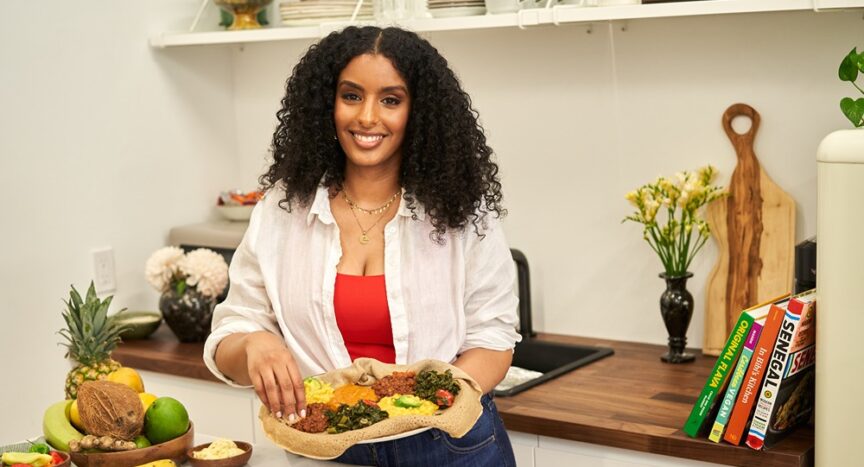Growing up in the predominantly white city of Windsor, Canada, meant there were very few Black food choices for Eden Hagos as a child. That all changed when she started driving.
“I would get in my car and go to Detroit, which was only a few miles away, and I got a taste of soul food,” said Hagos. The flavors and experience were unforgettable and connected her to some of the things she loved most about her family’s Ethiopian culture, especially the sense of community sharing Black food creates.
Moving to Toronto as a young adult furthered her exposure to the breadth of Black food. “The city has a huge Caribbean, East African and West African community,” she added. “So there’s a rich food culture with lots of diverse options.”

Despite loving Black food, Hagos shared that she often looked to other cuisines for special events. But that changed abruptly a few years ago.
“I went out to an Italian restaurant for my birthday, and my guests and I were treated horribly. They were clearly racist. And I kept thinking, ‘Why didn’t I even consider celebrating at a Black restaurant?’ I started challenging myself why I thought I had to go to a European space to celebrate. I decided I wanted to celebrate my food, my culture and Black food overall. That’s why I started Black Foodie,” she said.
Black Foodie is a dynamic movement that celebrates Black restaurants and recipes and offers Black food experiences in Toronto and the United States. Hagos anchors the brand in the communal nature of her Ethiopian roots. “The way we prepare and experience our food is in ways that always encourage sharing,” said Hagos. “You eat from the shared platters, you eat with your hands, and the food caters to all of your senses. It’s a social experience.”
As an entrepreneur, Hagos understood that she could transform these principles into events and create a community that makes people feel connected through spirited restaurant recommendations, colorful recipes and dynamic meetups. Black Foodie’s global reach—a community of more than 500k followers with events, expansive food content and robust directories—speaks to its success. “I get so many messages with people telling me they tried a restaurant because of a post,” she said. “For me, the easiest way to buy Black and support Black business is to do it with food.”

Staying connected to Black food culture has taken Hagos all over the world, and she currently splits her time between Washington, D.C. and Toronto. A consummate host, Hagos is a tea lover and often serves it to guests. “I always love to have tea with my meals, especially Ethiopian food. We dip our bread in it,” she said, then added, “Southern Black culture introduced me to sweet tea.”
This summer, Hagos suggests trying a little something different with your iced tea. She’s pairing traditional sweet tea with black-eyed hummus and flatbread.
“This is my twist on tradition. Why not have sweet tea with a flatbread and a dip that makes sense for the summertime? I like to have sweet tea with spicy food. And then black-eyed peas are such a big part of Southern and West African foods. Plus, I like an Ethiopian kick to the hummus. And it tastes really good,” she said. “I make this at home for my family, and they love it, so I wanted to share it with the extended EBONY family. I think they’ll love it, too.”
Find out more about Eden Hagos at Black Foodie or go to @Blackfoodie.co on Instagram.
Read Hagos’ black-eyed hummus recipe:
Black-Eyed Peas Hummus with an Ethiopian Kick
“I love this recipe because it’s super delicious and so simple to make! The black-eyed peas with the Ethiopian berbere spice is a match made in heaven. Berbere is the key to Ethiopian and Eritrean cooking. It’s a spice blend with over 13 ingredients, like ginger, chili peppers and Ethiopian black cardamom. I love adding a touch of East Africa to all my cooking and remixing traditional flavors. This spice adds a tasty kick to the black-eyed peas dip and pairs perfectly with Gold Peak’s Sweet Tea.” Try this out for your next summer cookout!
Ingredients
Black-Eyed Peas Hummus
- 1, 15 oz can black-eyed peas (2 cups)
- Tahini (⅓ cup)
- ¼ cup of fresh lemon juice ( juice of 1 lemon)
- 3-5 garlic small roasted garlic cloves (adjust to your taste, I think the more garlic the better)
- 2 Tbsp olive oil + more for topping finished hummus
- Pinch of cumin (optional)
- 2 cubes of ice or 2 tbsp of very cold water
- Salt to taste
Flatbread
- 5 to 6 pita bread rounds (I prefer Greek pita or any thick pita or flatbread like naan for dipping)
- Olive oil
- Salt
- Feel free to season with garlic powder, berbere spice or zataar too! Or sub out the bread for Injera crisps and keep things super healthy! (Injera is the Ethiopian spongy flatbread, you can find it at your local Ethiopian or Eritrean market)
Topping
- Fresh parsley
- Berbere spice
- Olive oil
Directions
Preheat oven to 375 and cut Greek pita into small pieces. Brush with olive oil and your favorite seasoning and bake until crispy
Drain and rinse black-eyed peas, then add to the food processor alongside tahini, lemon juice, and garlic. Process until smooth, add salt and cumin to taste. Then add olive oil and ice cubes or very cold water to get a smooth consistency.
Top with more olive oil, a generous sprinkle of Berbere spice and parsley. Serve with the crispy flatbread chips and a tall glass of Gold Peak Sweet Tea. Enjoy!





